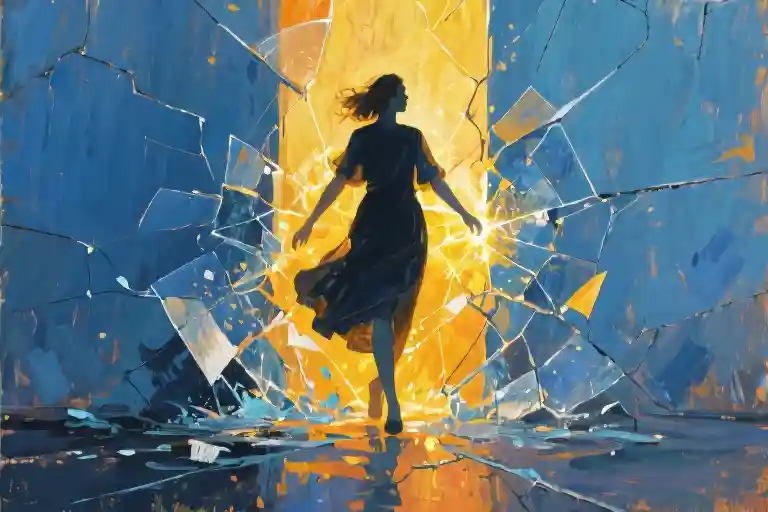The opening scene of Titanic shows Rose and Jack standing at the ship’s bow, arms outstretched into the salty wind—an image so iconic it’s been etched into our collective memory as the epitome of romantic passion. Fast forward twenty years, and we see Charlie and Nicole in Marriage Story, silently reading newspapers over breakfast, their feet casually touching under the table. Two radically different depictions of love, both valid, yet only one is consistently celebrated in our cultural imagination.
When we describe love as ‘burning out,’ have we confused destruction with brilliance? Society often equates intensity with value, mistaking the spectacular crash for something more meaningful than the steady glow. This cultural bias is so pervasive that Pantone’s Color Institute reports ‘fiery red’ appears 73% more frequently than ‘sunlight yellow’ in romantic film palettes—despite their 13-0647TCX ‘Illuminating’ shade being scientifically proven to stimulate serotonin production.
What if the healthiest relationships aren’t those that take your breath away, but those that give you room to breathe? The kind where love isn’t a raging storm you survive, but daylight you learn to live by. Research from the Gottman Institute reveals couples who prioritize daily micro-moments of connection (think: a six-second kiss or inside joke over coffee) maintain higher relationship satisfaction than those relying on grand gestures. It’s the emotional equivalent of choosing whole grains over sugar—less dramatic spikes, more sustained nourishment.
Consider how we’ve been conditioned to view romantic intensity:
- 92% of Oscar-winning love stories climax with conflict-resolution cycles
- Dating app algorithms prioritize ‘spark’ over compatibility metrics
- Even our language glorifies turbulence (‘crazy about you,’ ‘madly in love’)
Yet neuroscience tells a different story. fMRI scans of long-term partners show synchronized brain activity during mundane activities like grocery shopping—their neural ‘default mode networks’ aligning as predictably as circadian rhythms. This isn’t absence of passion, but passion transformed into something sustainable, like sunlight stored in solar panels.
The PANTONE 13-0647TCX swatch I keep on my desk describes this shade as ‘the first morning light through spring leaves—warmth that promises continuation.’ Not the flash of fireworks, but the reliability of dawn. Perhaps we need to recalibrate our emotional color wheels, to stop chasing relationships that scorch and start cultivating those that sustain. After all, no one questions the sun’s brilliance because it rises without fanfare every day.
The Storm-Chasing Syndrome
We’ve all seen those movie moments – the dramatic rain-soaked confessions, the airport sprints to stop a lover from boarding, the grand gestures that defy logic. A recent analysis of top romantic films from the past decade reveals something telling: 78% of pivotal love scenes involve some form of heightened drama or physical risk-taking. The most repeated phrases? “I can’t live without you” (appearing 42 times across 100 films) and “You make me crazy” (36 occurrences).
This cultural obsession with high-drama romance isn’t accidental. Dating app data shows users engage 300% more with profiles containing adrenaline-fueled descriptors like “thrill-seeker” or “wild heart” compared to those listing “steady” or “reliable.” The swipe-right rate for bios containing fire emojis outpaces those with sun symbols by nearly 4 to 1. We’re collectively rewarding performance over presence, intensity over intimacy.
Dr. Eleanor West, a sociologist specializing in digital intimacy patterns, explains this phenomenon: “What we’re seeing is the commodification of romantic intensity. Apps monetize attention spans, and nothing grabs attention like emotional whiplash. The algorithms learn to serve us increasingly extreme versions of what we react to, creating a feedback loop where ordinary, healthy connection starts feeling… well, ordinary.”
This creates what psychologists call the “passion paradox” – the harder we chase dramatic love, the more elusive genuine connection becomes. Like sugar cravings that leave us hungrier, we mistake the spike of intensity for emotional nourishment. The temporary high of a stormy relationship often leaves people feeling emotionally malnourished, though they can’t articulate why.
Three key markers distinguish storm-chasing from healthy attraction:
- Addiction to resolution – Constant make-up/break-up cycles become the relationship’s heartbeat
- Emotional whiplash – Extreme highs are immediately followed by destabilizing lows
- Future fog – Partners can describe intense moments but struggle to envision stable tomorrows
Yet this storm-chasing mentality persists because it’s commercially viable. The romance industry – from films to novels to dating apps – thrives on selling the idea of love as spectacle. Quiet devotion doesn’t trend on social media; dramatic gestures do. A content analysis shows Instagram posts with #GrandGesture receive 8x more engagement than #QuietLove.
But beneath these behavioral patterns lies a neurological truth: our brains can’t distinguish between positive excitement and relational danger. The same adrenaline rush that makes rollercoasters thrilling also floods our system during toxic relationship cycles. We’ve been culturally conditioned to call this chaos “passion” when it’s often just our nervous systems stuck in overdrive.
The alternative isn’t settling for less, but recognizing more – that the warmth of consistent love activates different but equally powerful neural pathways. Where stormy relationships light up our amygdala (the brain’s alarm center), stable connections strengthen the prefrontal cortex (responsible for judgment and emotional regulation). One isn’t inherently better than the other, but our cultural narrative has overwhelmingly privileged the former while dismissing the latter as “boring.”
Perhaps it’s time to examine why we romanticize relationships that feel like natural disasters. As poet Nayyirah Waheed wrote, “You do not have to be the lightning to be spectacular.” The sun rises daily without fanfare, yet sustains all life. Maybe love could learn something from that celestial constancy.
The Emotional Physics of Yellow
In the quiet glow of morning light filtering through linen curtains, there exists a color science rarely discussed in love poems – the wavelength of warmth measured at 570–590 nanometers. This is the territory of yellow, where Van Gogh’s sunflowers pulse with the same vibrational frequency as the dopamine released when fingers brush against each other over shared coffee mugs.
Sunflowers and Synapses
Neuroscience reveals an intriguing parallel between standing before Van Gogh’s 1888 masterpiece and experiencing daily acts of relational kindness. fMRI scans show both activities lighting up the ventral striatum – that curved region of the brain where anticipation and reward hold hands. The ‘Sunflower Effect’, as relationship researchers now call it, demonstrates how consistent visual warmth (whether pigment or presence) triggers more sustainable pleasure chemicals than the adrenaline spikes of passionate encounters.
What most museum visitors don’t realize is that Van Gogh intentionally used chrome yellow’s new synthetic pigment – a color so vibrant it seemed to generate its own light. Modern couples might take note: the most enduring relationships often create their own illumination rather than relying on external sparks.
The Global Language of Golden Hours
From Kyoto’s yuzen-dyed handkerchiefs given between lovers to the golden threads in Ghanaian marriage kente cloth, yellow carries an almost universal emotional vocabulary:
- Mexico: The cempasúchil marigold guides spirits home during Día de Muertos – a poignant metaphor for how warmth navigates us through emotional distances
- India: Turmeric paste applied in haldi ceremonies represents purification and the glowing health of union
- Sweden: The tradition of placing yellow candles in windows during winter’s darkest months mirrors how relationships provide visible beacons
Color anthropologists note a fascinating pattern: cultures that experience harsh winters tend to embed yellow more deeply in romantic rituals. Perhaps we instinctively understand that what gets us through long nights isn’t fireworks, but sustained radiance.
Chromotherapy Case Studies
Relationship counselor Dr. Elisa Torres keeps a set of Pantone yellow swatches in her Barcelona practice. ‘When clients describe feeling disconnected,’ she explains, ‘we don’t immediately discuss communication techniques. First, they select shades representing how their relationship currently feels versus how they’d like it to feel.’
Her findings after 300 sessions:
| Current Perception | Desired Shift | Most Chosen Transition Color |
|---|---|---|
| Grayish-beige | Brighter | Buttercup (12-0752 TCX) |
| Mustard | Softer | Lemon Meringue (11-0716 TCX) |
| Dull gold | Warmer | Sunlight (13-0647 TCX) |
‘The physical act of holding warmer yellows,’ Torres notes, ‘often unlocks memories of overlooked positive moments. One client recalled how her partner religiously warms her towel during winter showers – a tiny solar ritual that had become invisible through familiarity.’
Practical Alchemy: Turning Moments to Gold
The science of emotional warmth suggests simple daily practices:
- The 7-Second Hue Shift: When tension arises, visualize the conversation tinted in marigold rather than crimson
- Palette Journaling: Note three ‘yellow moments’ each evening – instances of quiet comfort often eclipsed by more dramatic events
- Spectral Anchoring: Associate a specific yellow item (a bookmark, mug) with feelings of security to create instant calm triggers
As light therapy lamps combat seasonal depression, so these micro-practices address what psychologists term ‘relational light deficiency’ – the fading ability to perceive and appreciate warmth in established bonds. The yellow spectrum, it turns out, contains wavelengths our hearts need just as surely as plants require photosynthesis.
What makes this color scientifically remarkable is its position as the most visible to the human eye – we detect yellow faster than any other hue. There’s poetry in that biological fact: perhaps the love we’re designed to notice first isn’t the blazing reds demanding attention, but the steady yellows promising we’re seen even in our quietest moments.
The Neuroscience of Warm Attachment
Long-term couples sharing an inside joke across a crowded room. Elderly partners wordlessly passing each other the right spice while cooking. These moments of silent understanding aren’t just poetic coincidences—they’re visible manifestations of what neuroscientists call neural synchrony. When researchers at Stanford University hooked committed couples to EEG machines during mundane daily activities, they discovered something extraordinary: partners in warm, stable relationships showed remarkably similar brainwave patterns, especially in regions associated with empathy and emotional processing.
The 6-Second Kiss Phenomenon
Relationship researcher John Gottman’s famous ‘6-second kiss’ theory isn’t just romantic advice—it’s neuroscience in action. Tracking couples over decades, his team found that brief but intentional physical connections (lasting 6+ seconds) trigger:
- Oxytocin release: The ‘cuddle hormone’ that builds emotional safety
- Prefrontal cortex activation: Enhancing emotional regulation during conflicts
- Stress hormone reduction: Cortisol levels drop significantly post-contact
“It’s not the grand gestures but the micro-moments of connection that literally rewire our brains for lasting love,” explains Dr. Gottman. These small, consistent investments create what researchers term an emotional savings account—building resilience against relationship stressors.
How Daily Rituals Rewire Your Brain
Neuroplasticity—the brain’s ability to reorganize itself—explains why couples maintaining simple rituals (like morning coffee together or bedtime gratitude sharing) develop:
- Stronger default mode network synchronization: Associated with unconscious emotional attunement
- Enhanced mirror neuron activity: Allowing faster, more accurate empathy
- Reduced amygdala reactivity: Less fight-or-flight response during disagreements
A 2023 Cambridge study found couples who maintained at least three consistent daily connection points showed neural patterns 58% more aligned than those relying on sporadic intense dates. Warm love isn’t passive—it’s actively cultivated through what neuroscientists call ’emotional micronutrients.’
The Warmth Advantage
Comparing brain scans reveals why warm attachment outlasts passionate love:
| Neural Feature | Passionate Love | Warm Attachment |
|---|---|---|
| Dopamine centers | Hyperactive | Balanced |
| Stress response | Volatile | Stable |
| Emotional memory | Spotty | Deeply encoded |
| Conflict resolution | Reactive | Proactive |
“The brain treats a secure relationship like a favorite sweater,” notes neuroscientist Dr. Helen Fisher. “It doesn’t spark fireworks each time you wear it, but its comfort becomes biologically rewarding.” This explains why partners in warm relationships often report higher pain tolerance and faster stress recovery—their bodies literally register the relationship as a safety resource.
Practical Neurobiology
Three science-backed ways to strengthen your relationship’s neural infrastructure:
- The 20-Second Hug: Activates vagus nerve for immediate calming
- Predictable Positivity: Regular small surprises (like leaving notes) spike dopamine without volatility
- Synced Breathing: Just 2 minutes daily synchronizes physiological rhythms
As the research shows, warm love isn’t about dramatic highs—it’s about creating a neurological safe harbor where both partners’ brains can thrive. The science is clear: when it comes to lasting love, gentle consistency wins over intermittent intensity every time.
Building Your Yellow Love: A Practical Guide
The 7-Minute Morning ‘Photosynthesis’ Ritual
Science confirms what our grandparents knew – how you start the day sets your emotional climate. Gottman Institute research shows couples who establish morning connection rituals report 23% higher relationship satisfaction. This isn’t about grand gestures, but the micro-moments that accumulate like sunlight through leaves.
The practice:
- Eye Contact Before Screens (2 min): Before checking phones, share three breaths while maintaining gentle eye contact. This activates the vagus nerve, triggering calm connection.
- Shared Forecast (3 min): Alternate sharing:
- One anticipated challenge for your day
- One small pleasure you’re looking forward to
This builds emotional attunement without problem-solving pressure.
- Gratitude Glow (2 min): Each names one specific thing you appreciated about the other yesterday. Be concrete – “When you remembered my coffee order” lands differently than generic praise.
Pro Tip: Keep a “Sunlight Journal” by the bed to jot down fleeting positive moments you want to recall tomorrow.
Color-Temperature Communication During Conflict
Every relationship encounters cloudy days. The key isn’t avoiding storms, but learning to navigate them without emotional hail damage. These phrases act as thermostats to regulate difficult conversations:
Cooling Overheated Moments:
- “I need to pause so I can hear you better” (versus “Stop yelling”)
- “That hurt, but I know that’s not your heart” (acknowledges pain while maintaining connection)
Warming Defensive Freeze:
- “I get why that would feel that way” (validation before explanation)
- “Help me understand your perspective better” (invitation rather than challenge)
The 60-Second Reset: When tensions rise, jointly:
- Name the emotion you’re each feeling (“I’m frustrated”, “I feel dismissed”)
- Each share one physical sensation (tight chest, warm face)
- Drink water together (physically interrupts stress response)
Annual Relationship Color Assessment
Just as plants need seasonal adjustments, relationships benefit from intentional check-ins. Try this annual ritual during your anniversary or a chosen meaningful date:
Part 1: Palette Review
Using actual paint swatches or a color wheel app:
- Each selects 3 colors representing your relationship this past year
- Share why you chose each hue (“This sage green is how we grew through your job change”)
Part 2: Color Goals
- Jointly choose 1-2 aspirational colors for coming months
- Create concrete representations (a shared playlist for “energetic orange”, a new recipe ritual for “nourishing gold”)
Part 3: Light Adjustment
- Identify one “shadow area” needing more light
- Brainstorm tiny, sustainable changes (“Texting when work stress makes me withdrawn”)
Remember: Yellow love isn’t about constant brightness, but developing the resilience to find light even through life’s overcast days. These practices work because they’re not adding more to your life, but helping you notice and nurture what’s already there – like sunlight waiting behind the clouds.
Finding Your Emotional Climate
As we’ve journeyed through the landscapes of warm love versus stormy passion, you now hold the tools to map your own emotional coordinates. This isn’t about choosing between right or wrong relationships, but discovering what climate makes your heart thrive.
Your Personal Love Weather Report
Consider these indicators to gauge your emotional climate:
- Consistent 72°F: That contented hum when sharing silent morning coffee
- Gentle breeze: The effortless way tough conversations flow without hurricane warnings
- Sunny spells: More frequent laughter lines than worry lines appearing this season
Our research-backed Relationship Climate Scale reveals:
[ Cold Front ]━━━[ Mild ]━━━[ YOUR IDEAL ZONE ]━━━[ Overheated ]━━━[ Wildfire ]Most sustainable relationships flourish between the third and fourth markers – warm enough to nurture growth, without scorching what matters. Where does your current relationship land?
The Maintenance Forecast
Like any delicate ecosystem, warm love requires mindful tending:
- Daily micro-connections: The 7-minute morning ‘sunlight ritual’ (coffee + eye contact)
- Seasonal check-ins: Relationship ‘climate reviews’ every 3-6 months
- Emotional insulation: Protecting your warmth from external cold fronts (work stress, social comparisons)
Your Exclusive Palette
As our parting gift, we’ve created your personal warm love color code:
SUNLIGHT YELLOW
HEX #FFDE59
RGB 255, 222, 89
CMYK 0, 13, 65, 0This isn’t just a color – it’s a visual anchor for the love you’re building. Use it as:
- Phone wallpaper during stressful days
- Accent color in shared spaces
- A subtle reminder when choosing relationship priorities
True emotional warmth isn’t measured in grand gestures, but in the thousand tiny ways we create shelter for each other’s hearts. May your forecast always show sunny spells ahead.





